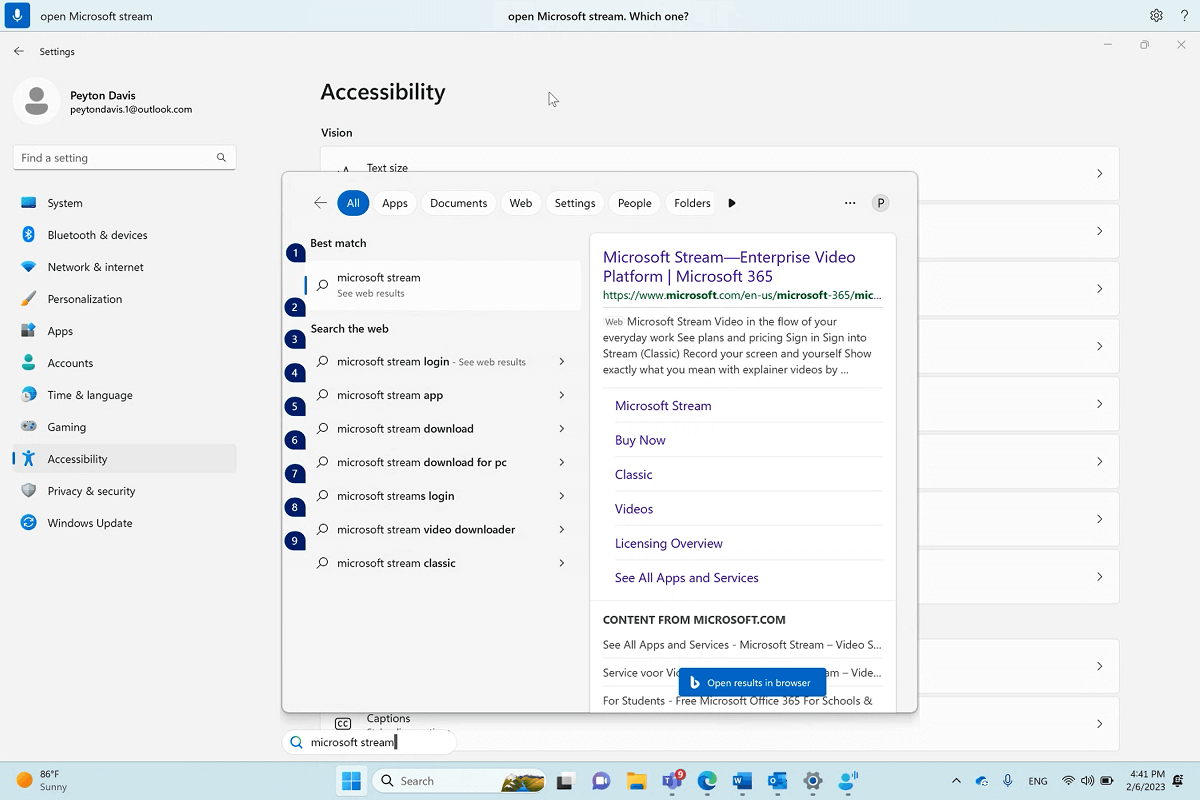This article is for people who want to control their PC and author text using their voice with Windows. This article is part of the Accessibility support for Windows content set where you can find more information on Windows accessibility features. For general help, visit Microsoft Support home.
With voice access, there are several ways to control your current active window and to work with multiple apps and windows. For a list of voice access commands, go to Voice access command list.
Voice access is a feature in Windows 11 that enables everyone to control their PC and author text using only their voice and without an internet connection. For example, you can open and switch between apps, browse the web, and read and author email using your voice. For more information, go to Use voice access to control your PC & author text with your voice.
Voice access is available in Windows 11, version 22H2 and later. For more information on Windows 11 22H2 new features, and how to get the update, see What's new in recent Windows updates. Not sure which version of Windows you have? See: Find Windows version.
In this topic
Open and close apps
|
To do this |
Say this |
Example |
|---|---|---|
|
Open a new app. |
"Open <app name>" |
"Open Edge" or "Open Word" |
|
Close an open app. |
"Close <app name>" |
"Close Edge" or "Close Word" |
Note: If voice access is unable to find the app you want to open or switch to, it opens the Windows search box and enters the name of the app you are trying to open. The search results get a numbered overlay on them, and you can simply choose the number that matches the app you want to open. To cancel the operation and try the "Open" command again, say "Cancel" to dismiss the overlay. For example, when you say "Open Microsoft Stream," you might see the following search results with the numbered overlay.
Switch between open windows
|
To do this |
Say this |
Example |
|---|---|---|
|
Switch to an existing app. |
"Switch to <app name>" or "Go to <app name>" |
"Switch to Edge" or "Go to Word" |
|
Open task switcher. |
"Show task switcher" |
If there are multiple instances of the same app already open when you use the "Switch" command, voice access attaches a number overlay to the windows, and asks you to pick the instance you want.
For example, if you have two instances of Microsoft Edge open when you say "Switch to Edge," voice access will show you the windows from the taskbar, with numbered labels on them, and asks you to select the number of the window you want to open.
Note: If you do not have the app open when you use the "Switch" command, voice access will open a new instance of the app.
Control windows
|
To do this |
Say this |
Example |
|---|---|---|
|
Minimize an app or a window. |
"Minimize window" or "Minimize <app name>" |
"Minimize Edge" or "Minimize Word" |
|
Maximize an app or a window. |
"Maximize window" or "Maximize <app name>" |
"Maximize Edge" |
|
Restore an app or a window. |
"Restore window" or "Restore <app name>" |
"Restore Edge" |
|
Close an open app or a window. |
"Close window" or "Close <app name>" |
"Close Edge" |
|
Go to desktop. |
"Go to desktop" |
|
|
Snap a window to left, right, top-left, top-right, bottom-left, or bottom-right. |
"Snap window to <direction>" |
"Snap window to left" |
Note: If the focus shifts from the current window and the "Minimize," "Maximize," or "Close" commands do not work, you can bring the focus back by using the grid overlay. For instructions, refer to the section "Move the mouse pointer with the grid overlay" in Use the mouse with voice.
Scroll through a window
Voice access offers several commands that you can use to scroll through a window.
Note: You can scroll when your mouse pointer is in a scrollable region. Note that a scroll bar may not always be visible in a scrollable region. If you have an app with multiple scroll bars, use the grid to bring the focus to a specific region. For more information about the grid, refer to the section "Move the mouse pointer with the grid overlay" in Use the mouse with voice.
|
To do this |
Say this |
Example |
|---|---|---|
|
Scroll left, right, up, or down. |
"Scroll <direction>" |
"Scroll up" |
|
Start scrolling left, right, up, or down. |
"Start scrolling <direction>" |
"Start scrolling down” |
|
Stop scrolling. |
"Stop scrolling" or "Stop" |
|
|
Scroll to the top or bottom. |
"Scroll to top" or "Scroll to bottom" |
|
|
Scroll to the left or right edge. |
“Scroll to left edge” or “Scroll to right edge” |
See also
Technical support for customers with disabilities
Microsoft wants to provide the best possible experience for all our customers. If you have a disability or questions related to accessibility, please contact the Microsoft Disability Answer Desk for technical assistance. The Disability Answer Desk support team is trained in using many popular assistive technologies and can offer assistance in English, Spanish, French, and American Sign Language. Please go to the Microsoft Disability Answer Desk site to find out the contact details for your region.
If you are a government, commercial, or enterprise user, please contact the enterprise Disability Answer Desk.













